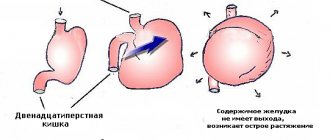What is dilated cardiomyopathy?
Cardiomyopathy is a pathology of the heart muscle, which is accompanied by disruption of the myocardium, the pumping function of the organ decreases, and blood circulation slows down. As a result, the pet is diagnosed with arrhythmia and heart failure.
The disease is classified into primary and secondary types. The first occurs against the background of congenital developmental defects, but is rare. The second develops as a complication against the background of a viral, bacterial or fungal disease.
The disease is also divided according to the type of changes in cardiac tissue. The most common type is dilated cardiomyopathy. The walls of the heart lose their elasticity, which prevents them from contracting. All chambers expand, the rhythm is disrupted.
Other varieties
Perhaps the most common type of pathology is dilatation. Often it replaces hypertrophy. What it is? Imagine a rag dangling in the water... An amorphous, unstable formation, reminiscent of a jellyfish. Now imagine that the heart wall has a similar texture. Can such a structure contract normally? Of course not. Severe conditions of hypoxia occur; the dog cannot walk even a hundred meters without starting to choke. Such animals do not live long, the prognosis is unfavorable.
However, restrictive cardiomyopathy also does not lead to anything good. With this pathology, fibrous fibers are formed in the thickness of the cardiac tissue. To put it simply, the organ turns into a kind of analogue of cartilage in its properties. It is not difficult to understand that such a heart practically cannot contract, and the animal, in addition to severe hypoxia, also receives severe, constant pain in the chest.
Read also: ICD 10 cardiomyopathy
Finally, with mixed caridomyopathy, everything can be observed at once. Of course, the situation when one ventricle is hypertrophied, the second is dilated, and fibrosis has begun in the atria is in reality weakly probable, but a combination of hypertrophy and fibrosis is quite possible.
Causes of occurrence in dogs
Factors contributing to the development of pathology have not yet been fully studied. It is only known that large breeds are most prone to the disease. There are several types of dogs that have a genetic predisposition to heart disease:
- boxers;
- Doberman pinschers;
- Newfoundlands;
- Portuguese water dogs;
- Great Danes;
- cocker spaniels (the only small breed at risk).
In addition, according to statistics, the incidence rate of males is more than 70%.
Speaking about the reasons, doctors agree that DCM is the result of metabolic disorders that were not cured in time. Also provoking factors are:
- Infectious diseases.
- Inflammatory processes.
- Disruption of the thyroid gland and metabolism.
- Toxic effects of drugs or poisons.
- Pathologies of coronary circulation.
- Changes in the functioning of the heart valve and myocardium.
The disease develops especially quickly against the background of low immunity, vitamin deficiency (in particular, lack of vitamin B12, tocopherol and selenium), lack of L-carnitine and taurine.
With this they read:
Quite often, your pet’s illness may be associated with diseases of the cardiovascular system. When treating small animals, approximately a tenth of them end up with one or another cardiac pathology, of which 10% are congenital.
According to statistics, 15% of cats and dogs suffer from heart pathologies even at an early age. As they age, many of them - up to 60% to be exact - fall into the group of animals at risk of heart failure.
Read also: Arrhythmogenic right ventricular cardiomyopathy
Heart failure is a severe pathology in which the heart, for a number of reasons, is not able to deliver the required volume of blood to the organs and tissues. As a result, the body suffers from a lack of oxygen and nutrient substrates
Heart failure is a condition in which the heart is unable to provide sufficient blood flow. As a result, organs and tissues suffer from oxygen starvation and nutritional deficiency.
Abdominal dropsy, or ascites, in cats is a secondary disease that is a consequence of renal, liver and heart failure, as well as a number of other quite serious diseases that provoke the accumulation of peritoneal fluid.
One of the most common heart diseases in cats is hypertrophic cardiomyopathy. With this pathology, the myocardial wall thickens, the volume of the heart chambers decreases, and heart failure gradually develops.
Heart disease, both congenital and acquired, is quite common in cats. Their characteristic feature is constant progression; the onset is usually missed due to nonspecificity or lack of visible symptoms. Since a violation of the pumping function leads to a deterioration in the functioning of other organs
Congenital heart defects in dogs account for about 15% of all diseases of the cardiovascular system. They are manifested by circulatory disorders due to organic changes in the structures of the heart. In most cases, the pathology is genetically determined, so the sick animal is excluded from breeding.
Symptoms of DCM
The clinical picture can vary greatly, as sometimes the disease actively progresses, and sometimes it develops completely asymptomatically for several years. In some cases, the pet dies suddenly, even before signs of pathology appear.
However, you should consult a doctor if:
- The dog has become lethargic, sleeps a lot, and refuses to go for long walks.
- After a short run or slight excitement, heavy breathing appears.
- There is a dry and hacking cough.
- When examining the mouth, it is clear that the mucous membranes have become paler.
- Episodes of loss of consciousness are possible.
- Cramps occur periodically during sleep.
- The pet's weight has decreased, but the size of the abdomen has increased (ascites). Water accumulates in the abdominal cavity, which interferes with the functioning of internal organs.
- When measuring pressure, the readings are below average.
- A characteristic but optional symptom is gurgling during breathing. It occurs against the background of pulmonary edema.
The disease is dangerous because the characteristic signs appear too late, when the process of deformation of the heart muscle is already irreversible. Pathology in the latent stage can only be determined with the help of a routine ultrasound of the heart; animals at risk are recommended to have it performed once a year.
How to diagnose the disease?
The primary diagnosis is made based on a general examination of the pet and the owner’s complaints. The doctor examines:
- Mouth. The mucous membranes are pale or bluish in color, and the capillary refill rate is longer than normal.
- Measures heart rate, femoral artery heart rate is weakened.
- There may be a pulse deficit (if arrhythmia has already developed).
- Listens to breathing; in the presence of wheezing and shortness of breath, it is important to exclude pulmonary edema and respiratory diseases.
- Palpates the abdomen for fluid accumulation.
To confirm the diagnosis, the following studies are performed:
- Ultrasound. Determines the presence of pathologies in the structure of the organ.
- Chest X-ray. Shows how the shadows of the heart, atrium, and trachea change (in some cases).
- ECHO KG. Shows changes in ventricular size, mitral valve insufficiency. In the later stages, arrhythmia, high pressure in the pulmonary artery, and an increase in atrium volume are visible.
- EGC. The intervals between contractions indicate the presence of disturbances in the heart rhythm.
Note that all signs of the development of the disease are not necessary. Some of them arise only at a late stage. In Doberman pinschers and boxers, no changes in the structure of the myocardium and ventricles are observed for 2-3 years. In them, DCM manifests itself only in the form of arrhythmia.
Canine dilated cardiomyopathy. Diagnostic features
October 25, 2011
Illarionova V.K.
Cardiomyopathies are a group of myocardial diseases that were described relatively recently - in the late fifties of the twentieth century in the medical literature and in the seventies in veterinary publications. Since then, this group of pathologies of the heart muscle has aroused continued interest among clinicians, morphologists and geneticists. Over the past 20 years, significant progress has been made in the study of cardiomyopathies in animals and humans, for example, such a separate form of pathology as arrhythmogenic dysplasia of the right ventricle in humans and Boxer dogs has been described, a rare form of restrictive cardiomyopathy has been identified in humans and cats, and genetic factors have been identified. factors in the occurrence of various forms of pathology in humans and certain breeds of dogs and cats. Over the past twenty years, there has been a real breakthrough in the ability to diagnose and treat cardiomyopathies in pets, but despite obvious progress, many clinical issues are far from being resolved.
The term "cardiomyopathy" was proposed by W. Brigden in 1956. According to the WHO classification of 1980, cardiomyopathy is a myocardial disease of unknown etiology. Based on structural, hemodynamic and clinical features, three main forms of pathology are distinguished: dilated, hypertrophic and restrictive. Veterinary and medical classifications are the same.
Dilated cardiomyopathy (DCM) is one of the most commonly diagnosed myocardial diseases in dogs. Large and giant breed dogs are predisposed to this pathology. The exception is cocker spaniels, the only small breed known to have DCM. In some breeds, the genetic nature of the disease has been proven, so the pathology can be transmitted by an autosomal dominant type in Newfoundlands, Boxers and Doberman Pinschers, by an autosomal recessive type in Portuguese water dogs and by a recessive type associated with the X chromosome in Great Danes. Males get sick 2-3 times more often. One UK retrospective study analyzed a group of 369 dogs with DCM. Large breeds accounted for 95%. Males accounted for 73%. The most commonly encountered breeds were Doberman Pinschers and Boxers (Martin MW, Stafford Johnson MJ, Celona B; J Small Anim Pract. 2009 Jan).
The classic form of DCM is characterized by diffuse dilation of all chambers of the heart, impaired myocardial contractile function, rapid development of heart failure and rhythm disturbances. On pathological examination, the heart is greatly enlarged due to the expansion of all chambers and has a rounded shape (bovine heart - cor bovinum). Eccentric myocardial hypertrophy is determined, but the heart muscle appears thinner as a result of pronounced dilatation of the cavities. The fibrous rings of the atrioventricular valves are stretched, the papillary muscles are thinned and weakened. Histological examination reveals degeneration, necrosis of cardiomyocytes, multiple zones of fibrosis and mononuclear infiltration.
Clinical signs
As a rule, clinical signs appear in the later stages of the disease, when structural changes in the myocardium lead to functional failure of the heart and all the body’s adaptive mechanisms are disrupted. Most often, the first manifestations of the disease are signs of left ventricular failure: shortness of breath, cough (with this disease a quiet, infrequent cough is often recorded), congestive wheezing in the lungs. Typically, owners do not pay due attention to such symptoms, attributing them to a “common cold.” Signs of right ventricular failure appear later (after about two to three weeks) and include the appearance of ascites, less often pleural/pericardial effusion. With the appearance of signs of right ventricular failure, the phenomena of general weakness, exercise intolerance and cardiac cachexia progress. Sometimes the manifestation of the disease occurs very quickly, simulating acute heart failure. Such a sharp decompensation of chronic heart failure can manifest itself as acute pulmonary edema with very severe shortness of breath, orthopnea and general weakness. Such a rapid course of the disease has a very poor prognosis. When the disease is complicated by rhythm disturbances, all symptoms are accompanied by episodes of loss of consciousness. Although in some cases, fainting may be the only symptom for quite a long time.
Physical examination
Physical examination findings in dogs in the early stages of the disease may be completely normal. Sometimes the only abnormality is a heart rhythm disorder (most often this occurs in Boxer and Doberman Pinscher dogs). At the stage of decompensation, signs of cardiomegaly are revealed: expansion and displacement of the apex beat of the heart downward and caudally. The pulse in the femoral artery is weakened. In case of atrial fibrillation, which is a common complication of DCM, a pulse deficit is determined. Blood pressure may be normal or low. Vascular insufficiency is manifested by pale mucous membranes and an increase in the capillary refill rate (CRF) of more than 2 seconds. With pulmonary edema, the mucous membranes acquire a bluish tint (Fig. 1).
Rice. 1 Cyanosis of the mucous membranes in a dog with pulmonary edema.
In the presence of such a symptom complex as cough, shortness of breath and orthopnea, it is necessary to exclude the presence of large pleural effusion or acute pulmonary edema. Hepatomegaly and ascites lead to abdominal enlargement. A large volume of ascites fluid is sometimes accompanied by swelling of the subcutaneous tissue of the pelvic limbs.
When auscultating the heart, muffled heart sounds, sometimes a third sound, can be heard; a weak systolic murmur at the apex of the heart can often be detected, which is a consequence of relative mitral valve insufficiency as a result of stretching of the mitral ring and dysfunction of the papillary muscles. With an irregular rhythm, such as frequent extrasystoles, ventricular tachycardia, or atrial fibrillation, such a murmur may be difficult to auscultate. When listening to the lungs, hard breathing or congestive wheezing is determined in the presence of interstitial or alveolar pulmonary edema.
Electrocardiographic study
In the early stages of the disease, the ECG may remain unchanged. In breeds prone to rhythm disturbances, rare ventricular extrasystoles are recorded at the onset of the disease. In our practice, there have been cases of detection of atrial fibrillation already in the early stages of the development of the pathology. With significant remodeling of the heart, signs of left ventricular enlargement are found: large amplitude of R waves in leads I, II, III, V4, V2. If intraventricular conduction is impaired, the R waves may become jagged. With pronounced fibrotic changes in the myocardium or the presence of pleural and/or pericardial effusion, the amplitude of the QRS complexes may be reduced. When the left atrium enlarges two or more times, P-mitral waves appear on the ECG, which are expanded for more than 0.05 seconds. With the development of significant pulmonary hypertension, the ECG records signs of enlargement/overload of the right atrium - high-amplitude (more than 0.4 mV) P-pulmonale waves (Fig. 2) and deep (more than 0.8 mV) S waves (especially in leads V4 and V2 ).
Rice. 2. Tall pointed teeth P (p-pulmonale).
In the later stages of heart failure, most dogs develop arrhythmias. The most common arrhythmia is atrial fibrillation (atrial fibrillation). Most often it is constant and has a tachysystolic form (Fig. 3).
Rice. 3. Tachysystolic form of atrial fibrillation.
A separate group consists of dogs of the Doberman Pinscher and Boxer breeds, in which DCM occurs with a long latent phase, sometimes lasting 2-3 years. During this period, the only deviation from the norm is a heart rhythm disturbance. In Dobermans, left ventricular extrasystole and ventricular tachycardia are most often recorded (Fig. 5). In boxers, extrasystoles and tachycardia are of proaventricular origin (Fig. 4).
Rice. 4. Right ventricular tachycardia.
Rice. 5. Paired ventricular extrasystoles.
Echocardiographic examination
An echocardiographic (EchoCG) study reveals an increase in the left and right parts of the heart, a significant decrease in the global contractility of the left ventricular myocardium (decrease in the values of the ejection fraction and shortening fraction) (Fig. 6.). Doppler cardiography can reveal the relative insufficiency of the mitral and tricuspid valves. In Doberman Pinschers, the normal size of the left ventricle is slightly lower than in dogs of other breeds with a body weight of 35-40 kg, therefore the end-diastolic size (EDD) of the left ventricle is more than 46 mm, and the end-systolic size (ESD) of the left ventricle is more than 39 mm are considered enlarged. With an advanced stage of the disease and significant expansion of the chambers of the heart, an echocardiographic study provides comprehensive diagnostic information, but if the pathology has not yet reached its full development, then additional echocardiographic studies using tissue Dopplerography are necessary.
Rice. 6. EchoCG of a dog with DCM (B- and M-modes). Significant increase in the cavity of the left ventricle and a decrease in global myocardial contractility.
Rice. 7. EchoCG of a dog with DCM. Significant increase in the size of the left atrium cavity.
X-ray examination
On radiographs in the lateral projection, generalized cardiomegaly is determined. At the same time, the shadow of the heart is large and round. The enlarged left atrium is manifested by enlargement and straightening of the caudodorsal part of the heart figure with the formation of a right angle pattern. An enlarged left ventricle results in straightening of the caudal edge of the heart (disappearance of the caudal cardiac waist) and closer contact with the diaphragm. The expansion of the right sections increases the cardiac shadow in the craniodorsal direction, which leads to the disappearance of the cranial cardiac waist and wider contact with the sternum. In this case, a dorsal displacement of the trachea is observed, which makes it parallel to the spine.
Cardiomegaly can be assessed by calculating the cardiovertebral score (VHS). VHS is the sum of the lengths of the short and long axes of the heart figure. The length of each segment is measured by the thoracic vertebrae, starting with T4. On average, the cardiovertebral indicator should not exceed 10.7 vertebrae (for boxers - 12.6 vertebrae). Disturbances in the pulmonary circulation that develop as a result of left ventricular failure are manifested by a diffuse increase in the density of lung tissue. In the initial stage of pulmonary edema, fuzzy (cotton-wool) darkening occurs at the roots of the lungs. As the edema progresses, the darkening spreads caudally. Air bronchograms appear - X-ray negative linear formations, reflecting air-filled bronchi surrounded by edematous lung tissue. With pulmonary edema, the width of the pulmonary vein of the cranial lobes of the lungs exceeds the width of the artery of the same name (normally their width should be the same).
Differential diagnosis of DCM with infiltrative myocardial diseases and myocarditis, which can also lead to cardiomegaly with a clinical picture identical to DCM, is difficult and may require a puncture biopsy of the myocardium. However, the differential diagnosis of these diseases is rather of theoretical interest, since the approaches to treatment are the same. Valvular heart defects leading to left side enlargement are easily identified with a thorough physical examination and echocardiography. Pericardial effusions and peritoneal-pericardial diaphragmatic hernia are easily diagnosed by echocardiography and contrast-enhanced radiography of the gastrointestinal tract.
Treatment of a sick pet
The treatment strategy depends on the phase of the disease and the condition of the pet. Unfortunately, there is no hope for a complete recovery, especially in the case of the primary type of pathology. Therapy will be aimed at increasing life expectancy, improving its quality, and alleviating unpleasant symptoms.
Emergency treatment
Ambulance is required due to the development of acute heart failure, which threatens the life of the animal. This treatment is carried out exclusively within the clinic and includes:
- Intravenous injections of Furosemide 5%. The drug quickly reduces pressure in the left ventricle of the heart and pulmonary artery, causing veins to dilate.
- Nitroglycerin spray or ointment (applied under the arms), the dosage is prescribed by the doctor depending on the condition. The remedy is designed to stop the attack.
- Medicines for inotropic support (Dopamine, Digoxin). Their goal is to maximally saturate the tissues with oxygen, without increasing cardiac output.
- Oxygen therapy (the animal is in an oxygen chamber). Gas with an increased O2 content is supplied to it. This is one of the first resuscitation measures, since in critical conditions all cells of the body suffer from hypoxia.
- In case of severe anxiety, the pet is given a sedative.
- If fluid has accumulated in the pleural cavity, thoracentesis is performed as part of first aid. A puncture is made in the pleura to pump out the contents and normalize respiratory function.
After an attack, the animal will need constant monitoring. The dog will stay in the clinic for 2-3 days, after which it will be prescribed maintenance treatment.
Video: What is DCM in dogs, its symptoms, treatment and prognosis
Symptoms of an enlarged heart in dogs
(Photo: Getty Images)
Symptoms of an enlarged heart in dogs can vary depending on how advanced the condition is. Sometimes veterinarians may miss signs of a dilated heart if dogs show no symptoms or only show mild signs of dilated cardiomyopathy. However, many subtle signs can be detected during a routine physical examination that would otherwise not be noticeable, so it is always important to keep up with normal checks. Here are some signs of an enlarged heart in dogs.
- Irregular or weak impulse
- Muffled breathing or crackling sounds when breathing
- lethargy
- Weakness
- Loss of appetite
- Weight loss
- Fast breathing
- Irregular breathing
- Exercise intolerance
- coughing
- Heart murmurs
- arrhythmia
- vomit
- Abdominal distension (ascites)
- Fainting (fainting)
- Sudden death











